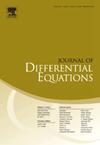Construction of Hunt processes by the Lyapunov method and applications to generalized Mehler semigroups
IF 2.3
2区 数学
Q1 MATHEMATICS
引用次数: 0
Abstract
It is known that in general, generalized Mehler semigroups defined on a Hilber space H may not correspond to càdlàg (or even càd) Markov processes with values in H endowed with the norm topology. In this paper we deal with the problem of characterizing those generalized Mehler semigroups that do correspond to càdlàg Markov processes, which is highly non-trivial and has remained open for more than a decade. Our approach is to reconsider the càdlàg problem for generalized Mehler semigroups as a particular case of the much broader problem of constructing Hunt (hence càdlàg and quasi-left continuous) processes from a given Markov semigroup. Following this strategy, a consistent part of this work is devoted to prove that starting from a Markov semigroup on a general (possibly non-metrizable) state space, the existence of a suitable Lyapunov function with relatively compact sub/sup-sets in conjunction with a local Feller-type regularity of the resolvent are sufficient to ensure the existence of an associated càdlàg Markov process; if in addition the topology is locally generated by potentials, then the process is in fact Hunt. Other results of fine potential theoretic nature are also pointed out, an important one being the fact that the Hunt property of a process is stable under the change of the topology, as long as it is locally generated by potentials. Based on such general existence results, we derive checkable sufficient conditions for a large class of generalized Mehler semigroups in order to possess an associated Hunt process with values in the original space, in contrast to previous results where an extension of the state space was required; to this end, we first construct explicit Lyapunov functions whose sub-level sets are relatively compact with respect to the (non-metrizable) weak topology, and then we use the above mentioned stability to deduce the Hunt property with respect to the stronger norm topology. As a particular example, we test these conditions on a stochastic heat equation on whose drift is given by the Dirichlet Laplacian on a bounded domain , driven by a (non-diagonal) Lévy noise whose characteristic exponent is not necessarily Sazonov continuous; in this case, we construct the corresponding Mehler semigroup and we show that it is the transition function of a Hunt process that lives on the original space endowed with the norm topology.
用Lyapunov方法构造Hunt过程及其在广义Mehler半群中的应用
一般来说,定义在Hilber空间H上的广义Mehler半群可能不对应于H中赋值为范数拓扑的càdlàg(甚至càd)马尔可夫过程。本文讨论了与càdlàg马尔可夫过程相对应的广义Mehler半群的刻画问题,这是一个高度非平凡的问题,并且已经开放了十多年。我们的方法是重新考虑广义Mehler半群的càdlàg问题,作为从给定的Markov半群构造Hunt过程(因此càdlàg和拟左连续)的更广泛问题的一个特例。遵循这一策略,本工作的一致部分致力于证明从一般(可能是不可度量的)状态空间上的马尔可夫半群出发,具有相对紧的子/子集的适当Lyapunov函数的存在性与解决方案的局部feller型正则性相结合,足以确保相关càdlàg马尔可夫过程的存在;此外,如果拓扑结构是由势局部生成的,则该过程实际上是Hunt。本文还指出了其他具有良好势理论性质的结果,其中一个重要的结果是,只要过程是由势局部产生的,它的亨特性质在拓扑变化下是稳定的。基于这些一般存在性结果,我们推导了一类广义Mehler半群的可检出充分条件,以使其在原始空间中具有具有值的关联Hunt过程,而不是以往需要扩展状态空间的结果;为此,我们首先构造其子水平集相对于(不可度量的)弱拓扑相对紧凑的显式Lyapunov函数,然后利用上述稳定性推导出关于强范数拓扑的Hunt性质。作为一个特殊的例子,我们在L2(D)上的一个随机热方程上检验这些条件,该方程的漂移由Dirichlet拉普拉斯算子在有界域D∧Rd上给出,由一个特征指数不一定是azonov连续的(非对角)l杂波噪声驱动;在这种情况下,我们构造了相应的Mehler半群,并证明了它是生活在具有范数拓扑的原始空间L2(D)上的Hunt过程的过渡函数。
本文章由计算机程序翻译,如有差异,请以英文原文为准。
求助全文
约1分钟内获得全文
求助全文
来源期刊
CiteScore
4.40
自引率
8.30%
发文量
543
审稿时长
9 months
期刊介绍:
The Journal of Differential Equations is concerned with the theory and the application of differential equations. The articles published are addressed not only to mathematicians but also to those engineers, physicists, and other scientists for whom differential equations are valuable research tools.
Research Areas Include:
• Mathematical control theory
• Ordinary differential equations
• Partial differential equations
• Stochastic differential equations
• Topological dynamics
• Related topics

 求助内容:
求助内容: 应助结果提醒方式:
应助结果提醒方式:


